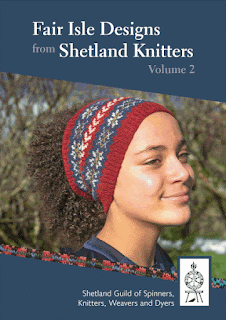The downside of having spent September writing about vermouth is that there have been a lot of exciting new books (cookbooks, ghost stories, tales of the weird, nature writing, and knitting based things have been piling up) and now I'm a bit overwhelmed and not sure where to start. Or how to fit everything in. It's a feeling exacerbated by what's happening at work - the shop closes on the 3rd of November which is beginning to feel very close.
Actually I do know where to start - it's Shetland wool week (maybe next year I'll actually make a plan to be there rather than just following it via Instagram) and volume 2 of 'Fair Isle Designs From Shetland Knitters' was released a couple of weeks ago. This is the 4th book published by the Shetland Guild of Spinners, Knitters, Weavers and Dyers and is definitely something to celebrate.
It contains a dozen patterns with something for every knitting level from more or less beginner through to fairly expert. My favourite is a spectacular all over jumper, followed by a really pretty child's jumper, and then a pair of Scandinavian inspired mittens but there's much more to this book than just patterns.
This volume has a history of the Guild which I've found really interesting. This is an important part of Shetlands knitting history so it's good to get it down whilst it's fresh. It's also really worth while to celebrate the work they're doing to keep the islands knitting heritage alive, thriving, and evolving. There's also the now traditional question and answer sections with the designers, and a wealth of technical information, and a glossary of Shetland words associated with knitting.
This word hoard is a particular gift to the reader. It's very much in line with keeping this heritage alive; both language and skills need to be passed on. Not so much to preserve them, though this approach obviously does that, but to maintain a link between generations of Shetland knitters (also spinners, weavers and dyers - maybe future books will be dedicated to some of these other skills too).
Rachel Hunters Lucky Clover tunic is a lovely example of this link between old and new. It's a modern looking shape that still harks back to the longline jumpers of the 1920's, uses traditional techniques but looks utterly contemporary.
Having words that belong with this knitting is it's own sort of inspiration as well as an echo of older voices. It's experts code words, and workers slang. I hope there are many more of these books to come.

No comments:
Post a Comment